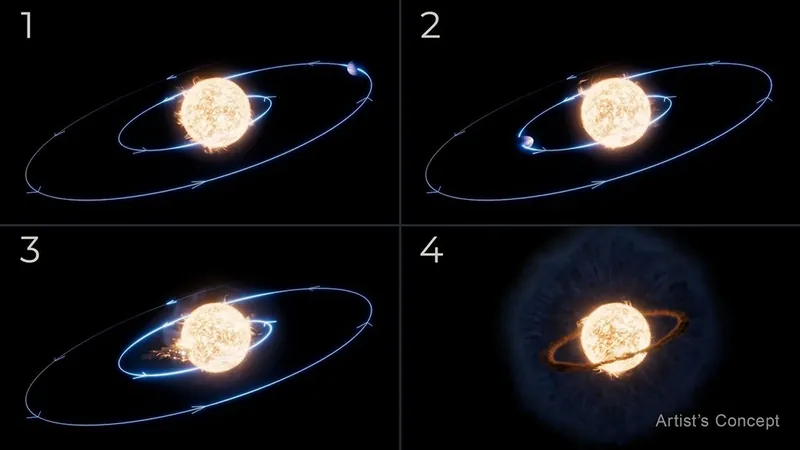
Stellar Drama Unveiled: The Mystifying Fate of a Planet Devoured by Its Star!
2025-04-15
Author: Amelia
Astronomers Witness a Planet's Spectacular Demise
In a groundbreaking revelation, astronomers have uncovered a cosmic drama unlike any other. In 2020, they observed what they thought was a star swallowing one of its orbiting planets. However, fresh insights from NASA's James Webb Space Telescope (JWST) have unveiled a surprising twist in this celestial saga.
A First of Its Kind Discovery
This extraordinary event, now named ZTF SLRN-2020, showcases a Jupiter-sized planet facing its doom, not by a star expanding into a red giant, but through a method far more sinister. Instead of the star puffing up, it actually pulled the planet in closer, ultimately consuming it. Ryan Lau, the lead author from the National Optical-Infrared Astronomy Research Laboratory, remarked, "It's not every day that we find these kinds of events. This is likely the first planetary engulfment event that was caught in the act."
A Celestial Mystery Unraveled
The star, located approximately 12,000 light-years away in the Milky Way, bared a brilliant flash of optical light, signaling the planet’s demise. Initially, researchers believed the star was simply aging like our Sun, destined to expand and engulf nearby planets as it exhausted its hydrogen fuel—a fate our own Sun will face in about 5 billion years.
The Shocking Truth
However, observations from JWST revealed a startling truth. The star was not glowing with the expected infrared light characteristic of a red giant. Instead, it was dimmer than anticipated, indicating that something was off about the expected lifecycle of the star.
How Did This Happen?
The research team proposes that the devoured planet was locked in an unusually tight orbit, even closer to its star than Mercury is to the Sun. Over time, this proximity led to orbital decay, a gripping phenomenon driven by the gravitational tides between the planet and its star. Within just a few months, the planet spiraled into the star’s surface and was subsequently pulled into its core, creating the initial optical light flash noted in 2020.
What Comes Next?
These events are notoriously difficult to detect due to their faint light signatures. However, with the future capabilities of the Vera C. Rubin Observatory, Ryan Lau expresses immense excitement: "We should be finding way more of these!" This opens the door for even more cosmic discoveries, illuminating the dark corners of our universe—and perhaps revealing more planets meeting similar fates.









 Brasil (PT)
Brasil (PT)
 Canada (EN)
Canada (EN)
 Chile (ES)
Chile (ES)
 Česko (CS)
Česko (CS)
 대한민국 (KO)
대한민국 (KO)
 España (ES)
España (ES)
 France (FR)
France (FR)
 Hong Kong (EN)
Hong Kong (EN)
 Italia (IT)
Italia (IT)
 日本 (JA)
日本 (JA)
 Magyarország (HU)
Magyarország (HU)
 Norge (NO)
Norge (NO)
 Polska (PL)
Polska (PL)
 Schweiz (DE)
Schweiz (DE)
 Singapore (EN)
Singapore (EN)
 Sverige (SV)
Sverige (SV)
 Suomi (FI)
Suomi (FI)
 Türkiye (TR)
Türkiye (TR)
 الإمارات العربية المتحدة (AR)
الإمارات العربية المتحدة (AR)